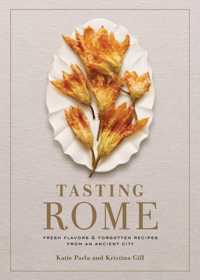
What do you get in Tasting Rome: Fresh Flavors & Forgotten Recipes from an Ancient City (Clarkson Potter 2016) by Katie Parla and Kristina Gill?
A visually stunning book that captures the food, the neighborhoods, the architecture, and the people of Rome in a truly personal way.
We both loved documenting Rome’s lost recipes and contemporary innovations and were eager to share dishes and stories that only a fully immersed Rome dweller could know. We enjoy celebrating new flavors and breaking down the stereotype that Roman food must be hypertrational in order to be authentic. (p. 12)
Rather than being jam-packed with recipes, the authors carefully choose the recipes they present and match them with photographs and essays on Roman food, restaurants, and products.
 For example, take a close look at Snacks, Starters, and Street Food. Rome has few cold months, so eating outdoors is popular. Light snacks are key. The first recipe is for Suppli Classici, or rice croquettes (pp. 38-9) “A crispy exterior gives way to a rich mixture of rice, chicken livers, pork sausage in a tomato-based sauce. The ‘surprise’ is a bit of melted mozzarella in the center.” The photograph of cracked open croquettes with cheese oozing from the center beats any kid’s dream of oozing pizza cheese. The following recipes are variations on the rice croquettes, with Pecorino Romano and Black Pepper (pp. 40-1), and Radicchio and Gorgonzola (pp. 42-3). In the photographs, there are street scenes of men chatting and snacking, and people in a café presumably about to order a suppli classici. If you aren’t hungry already, you will be.
For example, take a close look at Snacks, Starters, and Street Food. Rome has few cold months, so eating outdoors is popular. Light snacks are key. The first recipe is for Suppli Classici, or rice croquettes (pp. 38-9) “A crispy exterior gives way to a rich mixture of rice, chicken livers, pork sausage in a tomato-based sauce. The ‘surprise’ is a bit of melted mozzarella in the center.” The photograph of cracked open croquettes with cheese oozing from the center beats any kid’s dream of oozing pizza cheese. The following recipes are variations on the rice croquettes, with Pecorino Romano and Black Pepper (pp. 40-1), and Radicchio and Gorgonzola (pp. 42-3). In the photographs, there are street scenes of men chatting and snacking, and people in a café presumably about to order a suppli classici. If you aren’t hungry already, you will be.
Torta Rustica (pp. 46-9) is Italy’s answer to spanakopita or vegetable quiche – a puff pastry tart filled with greens (dandelion and chard) and ricotta, eggs and spices. The pictures show a pretty lattice top and deep green within. It’s perfect for an appetizer or a light lunch, with hopes for a good chunk left over for another meal.
They include an essay on Trapizzino, a modern take on a stuffed triangular sandwich, invented by Stefano Callegari (p. 51). The authors are excited by its possibilities – filled with Lingua in Salsa Verde (p. 139) or Pollo all Romana (p. 89) or even East African Zighini. “When viewed as a whole, his trapizzino menu perfectly encapsulates Rome’s local flavors, both native and imported.” This isn’t a city frozen in time by its ancient architecture – but a vibrant, inventive city.
Some of the recipes are as simple as Fave, Peccorino, e Corallina or Fava Beans, Pecorino, and Salami (p. 56) that could be eaten to celebrate May Day or any other day you can find fresh fava beans. The lovely green beans, the white cheese, and the red salami marry salty to sweet and peppery perfectly.
There are plenty more dishes to explore from fried squash blossoms to crostini and bruschetta in this first chapter.
Perhaps we were wrong: this is a book jam packed with recipes – recipes you want to cook and enjoy. It will also make you long to go to Rome again. Tasting Rome is like having a private tour guide whose specialty is tantalizingly good food.
